15 cm SK L/35
The 15 cm Schnelladekanone Länge 35, abbreviated as 15 cm SK L/35, was a German naval gun developed in the years before World War I that armed a variety of warships from different nations. The navies of Austria-Hungary, China, Denmark, Japan, The Netherlands, The Ottoman Empire, Romania and Spain all used this gun.
| 15 cm SK L/35 | |
|---|---|
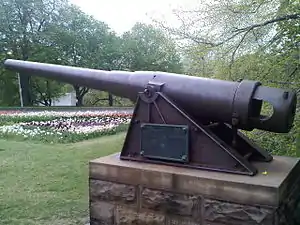 Gun from Spanish cruiser Castilla, sunk at the Battle of Manila Bay in 1898. Near Highland Park, Rochester, NY. | |
| Type | Naval gun |
| Service history | |
| In service | 1883-1923 |
| Used by | German Empire Austria-Hungary China Denmark Japan The Netherlands The Ottoman Empire Romania Spain |
| Wars | First Sino-Japanese War Spanish–American War Boxer Rebellion Russo-Japanese War World War I |
| Production history | |
| Designer | Krupp |
| Designed | 1880 |
| Manufacturer | Krupp |
| Produced | 1883 |
| No. built | 141 |
| Variants | Coastal Artillery Field Gun |
| Specifications | |
| Mass | 5.8 t (6.4 short tons) |
| Length | 5.25 m (17 ft 3 in) |
| Shell | Separate loading cased charge and projectile |
| Shell weight | 45.6 kg (101 lb) |
| Caliber | 149.1 mm (5.87 in) 35 caliber |
| Breech | Horizontal sliding breech block |
| Elevation | -7° to +20° |
| Rate of fire | 4-5 rpm |
| Muzzle velocity | 650 m/s (2,100 ft/s) |
| Maximum firing range | 10 km (6.2 mi) at +19°[1] |
History
In 1880 Krupp designed the 15 cm SK L/35 and started production in 1883 to arm protected cruisers, turret ships and coastal defense ships then under construction. It was also used to rearmed a number of earlier iron clad warships. Originally designed to use one piece ammunition 1.33 m (4 ft 4 in) long and weighing 68 kg (150 lb) the gun was redesigned to use two part quick loading cased charges and projectiles due to complaints about the size and weight of the ammunition. By breaking the ammunition down into two pieces the rate of fire was improved and crew workload was eased.[1]
Naval Use
German Empire
- Irene-class - This class of two protected cruisers had two 15 cm SK L/35 guns per side, amidships as their primary armament after 1899-1905 refits.
- SMS Kaiserin Augusta - This protected cruiser had six 15 cm SK L/35 guns per side, amidships as its primary armament after an 1896 refit.[2]
Austria-Hungary
- Kaiser Franz Joseph I-class - This class of two protected cruisers had three 15 cm SK L/35 guns per side, amidships as their secondary armament.[3]
- SMS Kaiserin Und Konigin Maria Theresia - This armored cruiser had four 15 cm SK L/35 guns per side, amidships as its secondary armament.[4]
- SMS Kronprinzessin Erzherzogin Stephanie - This ironclad had three 15 cm SK L/35 guns per side, amidships as its secondary armament.[5]
China
- Chih Yuen - This protected cruiser had one shielded 15 cm SK L/35 gun per side, amidships as its secondary armament.[6]
- Dingyuan-class - This class of two ironclads had a secondary armament of one 15 cm SK L/35 at the bow and stern.
- Kuang Yuan-class - This class of four gunboats had one 15 cm SK L/35 as their primary armament.[7]
- Lai Yuen - This protected cruiser had one shielded 15 cm SK L/35 gun per side, amidships as its secondary armament.[8]
- Pao Min - This cruiser had a primary armament of one forward 15 cm SK L/35 and a second gun on the quarterdeck.[9]
- Ping Yuen - This gunboat had one shielded 15 cm SK L/35 gun per side, amidships as its secondary armament.[10]
- Tsi Yeun - This protected cruiser had one shielded 15 cm SK L/35 gun, aft as its secondary armament.[11]
- Wei Yuen-class - This class of six sloops were each refitted with two 15 cm SK L/35 guns.[12]
- Zhenyuan - This turret ship had one shielded 15 cm SK L/35 gun, fore and aft as its secondary armament.[13]
Denmark
- HDMS Fyen - This unprotected cruiser mounted two 15 cm SK L/35 guns as its primary armament.[14]
- HDMS Gorm - This monitor had two 15 cm SK L/35 guns mounted in a central turret amidships as its primary armament after a 1903 refit.[15]
- HDMS Hekla - This protected cruiser had one 15 cm SK L/35 gun, fore and aft as its primary armament.[16]
- HDMS Valkyrien - This protected cruiser had three 15 cm SK L/35 guns per side, amidships as its secondary armament.[17]
Japan
- Naniwa-class - The two ships of this class of protected cruisers had three 15 cm SK L/35 guns per side, amidships as their secondary armament.[18]
The Netherlands
- Evertsen-class - This class of three coastal defense ships had one 15 cm SK L/35 gun per side, amidships as their secondary armament.[19]
- HNLMS Sumatra - This protected cruiser had one shielded 21 cm L/35 gun fore and one shielded 15 cm SK L/35 gun aft as its primary armament.[20]
The Ottoman Empire
- Hamidiye - This central battery ironclad had five 15 cm SK L/35 guns per side as secondary armament.[21]
- Iclaliye - This central battery ironclad was refitted with two 15 cm SK L/35 guns.[22]
Romania
- NMS Elisabeta - This protected cruisers primary armament consisted of two 15 cm SK L/35 guns per side, in sponsons amidships.[23]
Spain
- Aragon-class - In 1885 two ships of the Aragon-class of unprotected cruisers the Navarra and Castilla were refitted with two 15 cm SK L/35 guns per side, amidships as their primary armament.[24]
Land use
In addition to its naval artillery role the 15 cm SK L/35 was also used as coastal artillery in either armored gun turrets or on garrison mounts. The garrison mount consisted of a rectangular steel firing platform which sat on a concrete slab behind a parapet with a pivot at the front and two wheels at the rear to give a limited amount of traverse. The recoil system consisted of a U shaped gun cradle which held the trunnioned barrel and a slightly inclined firing platform with a hydro-gravity recoil system. When the gun fired the hydraulic buffers under the front slowed the recoil of the cradle which slid up a set of inclined rails on the firing platform and then returned the gun to position by the combined action of the buffers and gravity.[25]
Ammunition
Ammunition was of separate quick loading type with a cased charge and projectile. The charge for AP and Common shells weighed 8 kg (18 lb). The charges for Shrapnel were 3.7–5.2 kg (8.2–11.5 lb).
- The gun was able to fire:
- Armor Piercing - 41 kg (90 lb)
- Common shell - 43.7 kg (96 lb)
- Shrapnel - 29 kg (64 lb)[1]
Photo Gallery
| Wikimedia Commons has media related to 15 cm SK L/35. |
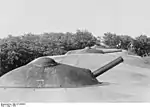 Three coastal defense turrets at Fort Huitschumhuk, Qingdao.
Three coastal defense turrets at Fort Huitschumhuk, Qingdao.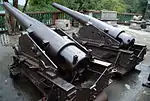 Coastal artillery at the Guangzhou Museum.
Coastal artillery at the Guangzhou Museum.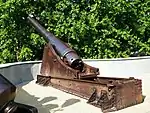 Coastal artillery at the Khabarovsk Krai Local Museum.
Coastal artillery at the Khabarovsk Krai Local Museum.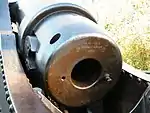 The breech block of a 15 cm SK L/35 at the Khabarovsk Krai Local Museum.
The breech block of a 15 cm SK L/35 at the Khabarovsk Krai Local Museum.
Notes
- Friedman, Norman (2011-01-01). Naval weapons of World War One. Seaforth. ISBN 9781848321007. OCLC 786178793.
- "KAISERIN AUGUSTA cruiser-corvette (1892) - Kaiserliche Marine (Germany)". www.navypedia.org. Retrieved 2017-04-02.
- "KAISER FRANZ JOSEPH I protected cruisers (1890–1892) - K-u-K Marine (Austro-Hungarian Navy) (Austria-Hungary)". www.navypedia.org. Retrieved 2017-04-02.
- "KAISERIN UND KÖNIGIN MARIA THERESIA armoured cruiser (1894) - K-u-K Marine (Austro-Hungarian Navy) (Austria-Hungary)". www.navypedia.org. Retrieved 2017-04-02.
- "KRONPRINZESSIN ERZHERZOGIN STEFANIE barbette ship (1889) - K-u-K Marine (Austro-Hungarian Navy) (Austria-Hungary)". www.navypedia.org. Retrieved 2017-04-02.
- "CHN Chih Yuen". navalhistory.flixco.info.
- "Kuang Yuan gunboats (1886) - Chinese / People's Liberation Army Navy (China / People's Republic of China)". www.navypedia.org. Retrieved 2017-04-02.
- "CHN Lai Yuen". navalhistory.flixco.info.
- "PAO MIN steel cruiser (1885) - Chinese Navvy (China)". www.navypedia.org. Retrieved 2017-04-02.
- "HEI YEN coastal defence ironclad (1889 / 1895) - Imperial Japanese Navy (Japan)". www.navypedia.org. Retrieved 2017-04-02.
- "CHN Chih Yuen". navalhistory.flixco.info.
- "WEI YUEN composite sloops (1877–1885) - Chinese Navvy (China)". www.navypedia.org. Retrieved 2017-04-02.
- "CHIN YEN turret citadel ironclad (1885 / 1895) - Imperial Japanese Navy (Japan)". www.navypedia.org. Retrieved 2017-04-02.
- "FYEN unprotected cruiser (1884) - Danish Royal Navy (Denmark)". www.navypedia.org. Retrieved 2017-04-02.
- "GORM turret ship (armoured battery) (1871) - Danish Royal Navy (Denmark)". www.navypedia.org. Retrieved 2017-04-02.
- "HEKLA protected cruiser (1891) - Danish Royal Navy (Denmark)". www.navypedia.org. Retrieved 2017-04-02.
- "Valkyrien protected cruiser (1890) - Danish Royal Navy (Denmark)". www.navypedia.org. Retrieved 2017-04-02.
- "NANIWA protected cruisers (1885 - 1886) - Imperial Japanese Navy (Japan)". www.navypedia.org. Retrieved 2017-04-02.
- "EVERTSEN coast defence ships (1895–1896) - Royal Dutch Navy (Netherlands)". www.navypedia.org. Retrieved 2017-04-02.
- "SUMATRA protected cruiser (1891) - Royal Dutch Navy (Netherlands)". www.navypedia.org. Retrieved 2017-04-02.
- "HAMİDİYE central battery ironclad (1894) - Ottoman Navy (Ottoman Empire)". www.navypedia.org. Retrieved 2017-04-02.
- "İCLALİYE barbette battery ironclad (1871) - Ottoman Navy (Ottoman Empire)". www.navypedia.org. Retrieved 2017-04-02.
- "ELISABETA protected cruiser (1888) - Romanian Navy (Romania)". www.navypedia.org. Retrieved 2017-04-02.
- "ARAGON unprotected cruisers (1881–1886) - Spanish Navy (Spain)". www.navypedia.org. Retrieved 2017-04-02.
- "German Colonial Uniforms". s400910952.websitehome.co.uk. Retrieved 2018-10-21.
References
- Friedman, Norman (2011). Naval Weapons of World War One. Barnsley, South Yorkshire, UK: Seaforth. ISBN 978-1-84832-100-7.